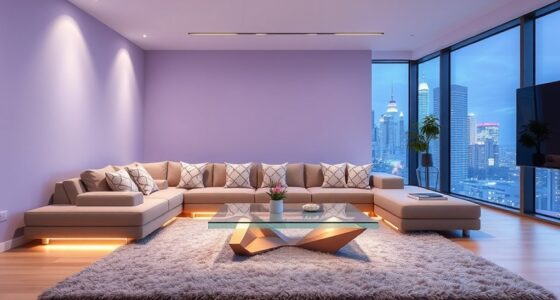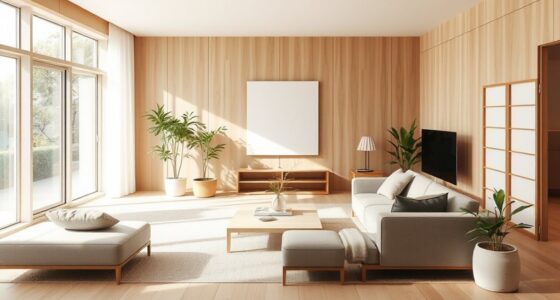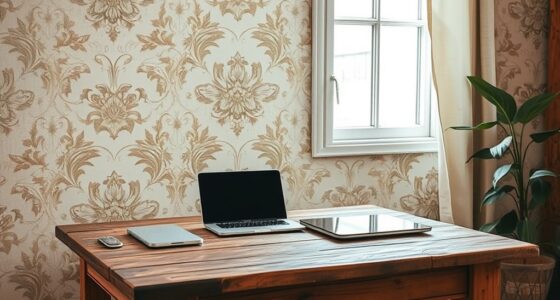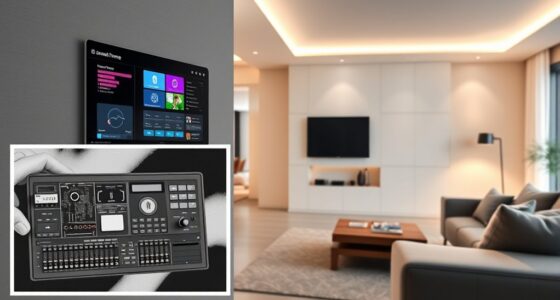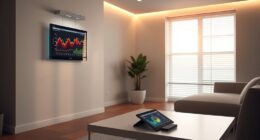From shag carpets and psychedelic wallpaper in the 1970s, home design has shifted toward sleek minimalism in the 80s and 90s. Then, open floor plans and multi-functional spaces became popular, followed by smart technology in the 2000s. Today, homes blend sustainability, Eco-friendly materials, and automation to create connected, eco-conscious environments. If you keep exploring, you’ll discover how future trends will shape even smarter and more sustainable living spaces.
Key Takeaways
- Home decor has shifted from bold, psychedelic 1970s styles to minimalist and sleek designs of the 1980s and 1990s.
- Open floor plans and multi-functional spaces have become standard for maximizing space and social interaction.
- Advances in technology led to smart homes with automation, remote control, and connected devices for enhanced convenience.
- Sustainability has gained importance, with eco-friendly materials, energy-efficient appliances, and biophilic design promoting eco-conscious living.
- Future trends focus on adaptive, personalized homes integrating advanced technology for sustainability, comfort, and flexibility.
The Groovy Era: 1970s Home Style and Decor
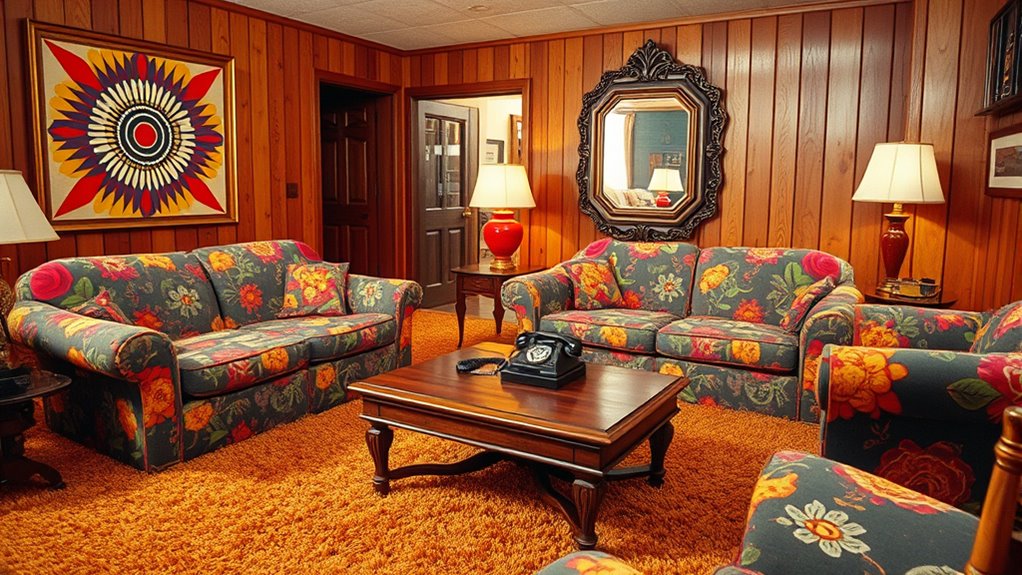
The 1970s home style and decor are characterized by bold colors, funky patterns, and a playful sense of individuality. You’ll notice the vibrant color palettes, featuring oranges, avocado greens, and browns that create a lively atmosphere. Wall coverings become a focal point, with psychedelic wallpapers and textured fabrics that add depth and visual interest. Patterns like geometric shapes, floral motifs, and swirling designs dominate walls and upholstery, reflecting the era’s adventurous spirit. These choices weren’t just aesthetic—they expressed personality and a desire to stand out. You might find wallpaper with abstract designs or textured wall panels that enhance the room’s dynamic vibe. Overall, this decade invites you to experiment boldly with color and pattern, transforming your space into a lively, expressive environment. Incorporating textured fabrics and layered textiles can further enhance the cozy, inviting feel typical of the era.
The Minimalist Shift: 1980s and 1990s Design Trends
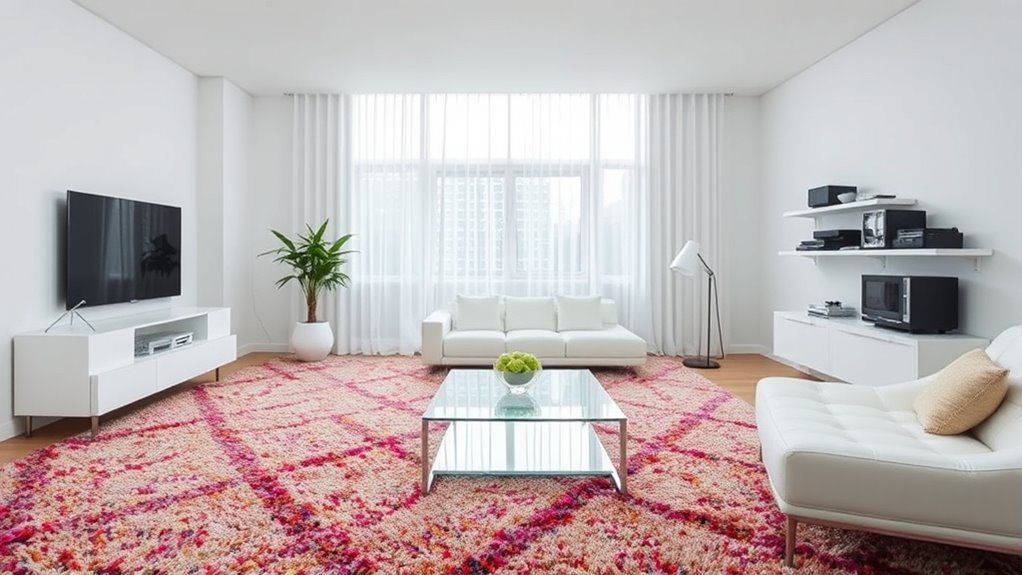
As the 1980s and 1990s unfolded, design trends shifted toward simplicity and clean lines, reflecting a desire for calm and order in home environments. You find yourself embracing clutter reduction, opting for minimal furniture and streamlined décor that create open, airy spaces. Monochrome palettes dominate, with neutral tones like beige, gray, and white promoting a sense of tranquility. You prioritize function over ornamentation, choosing pieces that are both practical and visually unobtrusive. This minimalist approach aims to eliminate chaos and focus on essential elements, making your home feel more spacious and organized. The trend encourages you to declutter regularly, emphasizing quality over quantity, and fostering a serene, clutter-free environment that promotes relaxation and clarity. Incorporating rustic decor can also add warmth and character without overwhelming the space.
The Rise of Open Floor Plans and Multi-Functional Spaces

Open floor plans and multi-functional spaces have become defining features of modern home design, reflecting a desire for flexibility and social connectivity. You now enjoy open areas that seamlessly combine living, dining, and kitchen spaces, encouraging interaction. To manage privacy and noise, homeowners often incorporate privacy screens and acoustic zones, creating dedicated spots for work or relaxation within the open layout. This approach maximizes space while maintaining comfort. Incorporating soundproofing techniques helps further reduce noise disturbance and enhances the functionality of multi-purpose rooms.
Technology Takes Center Stage: The 2000s and Early 2010s
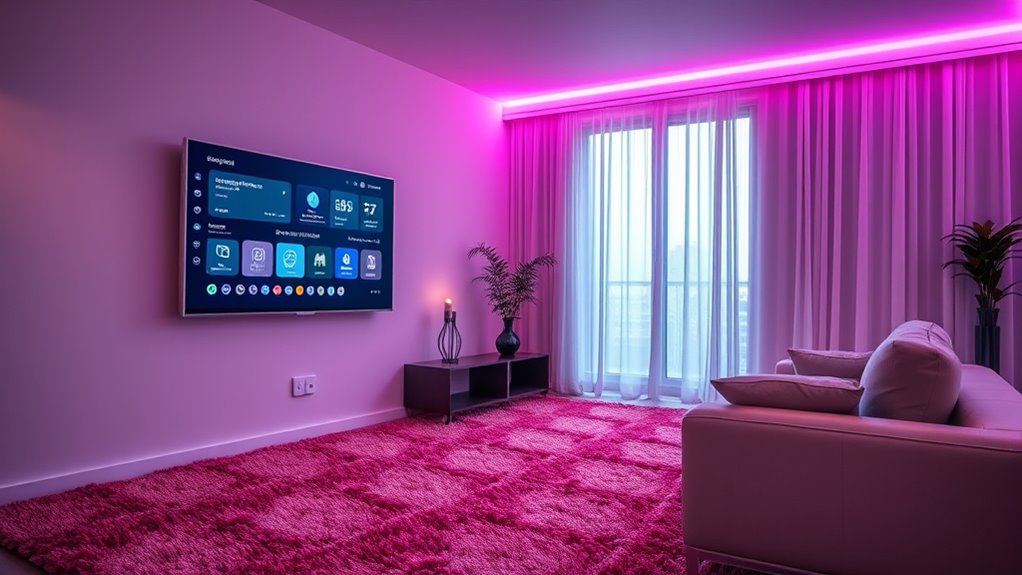
During the 2000s and early 2010s, technology became a central influence on home design, transforming how you live and interact within your space. Virtual reality started to change the way you experience your home, allowing you to visualize renovations or furniture placement before making decisions. AI integration also became more common, streamlining daily tasks through smart devices that learn your habits and preferences. Home automation systems gained popularity, giving you control over lighting, climate, and security from your smartphone or voice commands. These innovations made your living space more intuitive and efficient. As technology advanced, homes evolved from static spaces into dynamic environments that adapt to your lifestyle, making everyday life more convenient and connected. Additionally, understanding the nutritional value of juices became part of modern home health trends, encouraging healthier living practices.
Sustainable Living and Eco-Friendly Materials
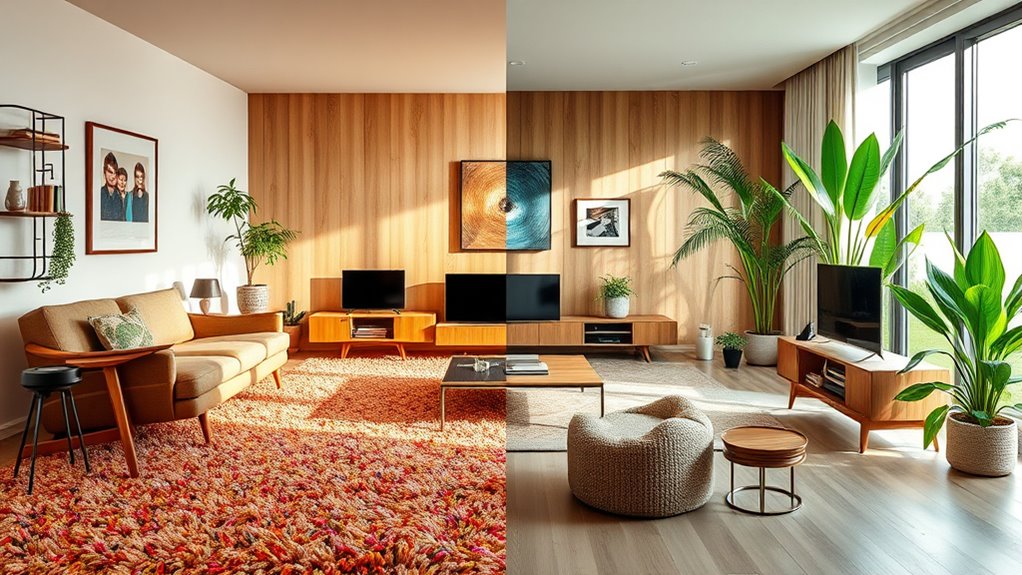
You’re increasingly choosing renewable building materials and eco-conscious design options to reduce your environmental impact. Manufacturers now prioritize low-impact practices that minimize waste and energy use. By making these choices, you contribute to a more sustainable and healthier home environment. Incorporating eco-friendly camper conversion options into your lifestyle can further support your commitment to sustainability.
Renewable Building Materials
As the demand for environmentally responsible building practices grows, renewable materials have become a vital part of sustainable construction. You can now incorporate materials like biodegradable composites, which decompose naturally and reduce waste. Recycled timber offers a durable, eco-friendly alternative to new lumber, minimizing deforestation. Using renewable building materials helps lower your project’s carbon footprint and promotes eco-conscious living. Consider these key points:
- Reduces reliance on non-renewable resources
- Lowers greenhouse gas emissions
- Supports circular economy principles
- Enhances building longevity and resilience
- Promotes healthier indoor environments
- Incorporating eco-friendly materials can also improve overall building efficiency and occupant well-being.
Low-Impact Manufacturing Practices
Have you ever wondered how manufacturing processes can minimize environmental impact while producing eco-friendly materials? You can play a role by supporting companies that prioritize low-impact manufacturing practices. These businesses often implement recycling initiatives, turning waste into valuable resources and reducing landfill contributions. They also focus on eco friendly packaging, using biodegradable or reusable materials to cut down on plastic waste. By choosing products made with these practices, you help lower carbon footprints and promote sustainability. These efforts ensure that materials are produced responsibly, with less energy consumption and fewer emissions. As consumers, your demand for greener options encourages manufacturers to adopt more environmentally conscious methods. Incorporating sound design techniques into manufacturing processes can also optimize resource usage and reduce noise pollution, further supporting sustainability goals. Ultimately, supporting low-impact manufacturing practices helps create healthier homes and a more sustainable planet for future generations.
Eco-Conscious Design Choices
Ever wondered how choosing eco-friendly materials and thoughtful design can transform your home into a sustainable space? Embracing eco-conscious design choices allows you to create a healthier environment while reducing your carbon footprint. Incorporate biophilic design to connect with nature, using natural light, plants, and organic materials. Opt for sustainable furnishings made from reclaimed wood or recycled metals. Aim for zero waste homes by reducing, reusing, and recycling materials wherever possible. Consider energy-efficient appliances and solar panels to cut down on energy consumption. Select eco-friendly paints and finishes to improve indoor air quality. These choices not only support the environment but also foster a calming, natural atmosphere in your living space. Investing in high contrast ratios in your home theatre setup can significantly enhance your viewing experience by providing deeper blacks and brighter whites, making your entertainment more vivid and engaging. Small changes make a big difference toward a more sustainable lifestyle.
The Smart Home Revolution: Connectivity and Automation

The smart home revolution is transforming daily living by making connectivity and automation more accessible than ever. With wireless security systems, you can monitor your home remotely, enhancing safety without complicated wiring. Voice assistants like Alexa or Google Home simplify managing your devices, allowing you to control lights, thermostats, and locks with a simple voice command. This integration creates a seamless experience, where everything is connected and responsive to your needs. Automation features enable your home to adapt to your routines, saving you time and energy. You no longer need to manually adjust settings or worry about forgetting to lock doors; your smart home takes care of it. Additionally, integrating craftsmanship and quality into your smart home setup ensures durability and reliability in all connected devices. This shift not only increases convenience but also boosts security and efficiency in your everyday life.
Current Trends: Blending Comfort, Sustainability, and Innovation

As smart home technology becomes more widespread, new trends are emerging that prioritize not just convenience but also comfort, sustainability, and innovation. You’re likely to see homes incorporating biophilic design, which brings nature indoors to enhance well-being and reduce environmental impact. Bi weekly decor updates keep your space fresh without waste, blending aesthetic appeal with eco-consciousness. These trends focus on creating spaces that are both functional and nurturing, promoting health and sustainability simultaneously. Incorporating energy-efficient smart appliances can further reduce environmental impact while enhancing daily comfort.
Looking Ahead: Future Trends in Residential Design
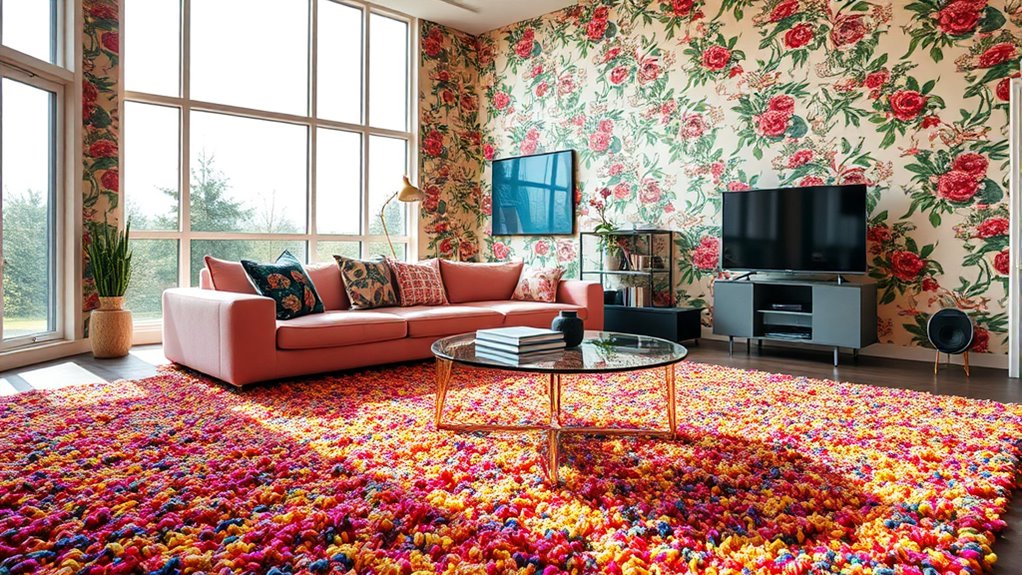
Looking ahead, residential design is set to evolve by integrating advanced technologies that enhance both functionality and sustainability. Futuristic architecture will likely feature sleek, innovative structures that prioritize energy efficiency and environmental harmony. Adaptive interiors will become more common, allowing spaces to transform based on your needs—think movable walls, smart furniture, and responsive lighting. These trends will enable homes to become more personalized and flexible, seamlessly adjusting to your lifestyle. Expect to see an increased focus on eco-friendly materials and systems that reduce carbon footprints. As technology advances, your living space will blend aesthetics with practicality, creating environments that are not only visually striking but also highly responsive to your daily routines. The future of home design promises to be smarter, more adaptable, and sustainable.
Frequently Asked Questions
How Did Home Trends Influence Social Behaviors Over the Decades?
Home trends shape how you socialize and connect over time. For example, open floor plans encourage more interaction during gatherings like garden parties, making entertainment more inclusive and lively. As homes evolve, they reflect and influence your social behaviors, promoting shared experiences and openness. You find yourself more engaged with others, creating a sense of community that’s influenced by design choices and overall trends in home living.
What Role Did Economic Shifts Play in Changing Interior Design Preferences?
You might find it surprising that during economic downturns, luxury home renovations drop by up to 60%, shifting design preferences toward affordability and practicality. Economic shifts profoundly influence interior design, prompting you to prioritize cost-effective choices over luxury. The luxury market shrinks, and you’re more likely to see minimalist, functional spaces instead of extravagant decor. These financial changes shape your home style, making affordability a key factor in your interior design decisions.
How Have Cultural Influences Shaped Home Decor Trends Historically?
You can see how cultural influences shape home decor trends through cultural symbolism and aesthetic movements. As societies evolve, they express their values, beliefs, and identities through decor choices. For example, you might notice the influence of Art Deco or Minimalism reflecting specific cultural ideals. These movements guide your preferences and inspire you to incorporate symbols and styles that resonate with your cultural background, creating a space that feels meaningful and authentic.
What Technological Innovations Have Had the Biggest Impact on Home Design?
Ever wonder how your home transforms with the latest tech? Smart gadgets and automation systems revolutionize design by making spaces more functional and personalized. You can control lighting, climate, and security remotely, creating convenience and efficiency. These innovations have shifted focus from purely aesthetic decor to integrated, intelligent environments. Isn’t it exciting how technology shapes a smarter, more connected living space? Your home’s future is now, at your fingertips.
How Do Future Trends Address Accessibility and Inclusivity in Homes?
Future trends focus on Universal Design and Adaptive Living, making homes more accessible and inclusive for everyone. You’ll see smarter layouts, adjustable features, and intuitive technology that cater to diverse needs, ensuring independence and comfort. These innovations help you create spaces that accommodate aging, disabilities, or changing requirements, fostering a sense of belonging and ease. Embracing these trends means building homes where everyone can thrive, regardless of ability or circumstance.
Conclusion
As you embrace the evolution of home trends, remember that blending beauty, brains, and sustainability shapes your space. From shag carpets to smart systems, each era offers inspiration for innovation. Stay savvy, sustainable, and stylish as you step into the future of living, where comfort, creativity, and connectivity collide. Your home’s history is your guide—grab the greatness of growth and go glow in the glow of tomorrow’s trends.


